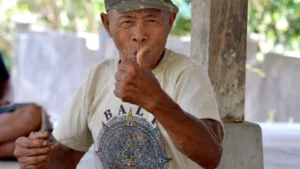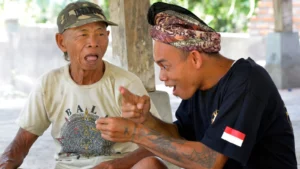The Deaf Village of Bali, Bengkala, has its own communication rule. According to research, in 2019, only 44 out of 3000 were born deaf in the village. However, rather than making them feel lonely, the rest of the villagers went into learning the language of the deaf.
Deciphering the Traditional Myth Of The Deaf Village Of Bali Using Scientific Outlook
As per the traditional myth of Bengkala, a long time ago, there was a corrupt king in the village. The local people resented his scrupulous activities. Infuriated by them, the king cursed the population of being deaf and mute forever.
Over the years, the village has earned its name for being home to an unusually large speech and hearing-impaired population. While the chances of congenital deafness are 0.01% for the rest of the globe, it s almost 2% for the deaf and mute population of Bengkala.
Keeping aside the myth part, scientists have their explanations, talking of mutation in the recessive gene DFNB3. Back in 1995, a research team employed a “direct genome-wide disequilibrium search schedule” and also went into analyzing historical recombinants. The main intention was to map out DFNB3, positioning the locus related to flanking markers. Also, the team combined the “allele frequency-dependent homozygosity” mapping (AHM) strategy.
Kata Kolok Sign Language In The Deaf Village Of Bali
For Bengkala Bali, deafness has existed as long as for the past eight centuries. When the locals came to know the scientific reason behind it, they actively incorporated the deaf and the dumb.
The Kata Kolok sign language serves as a major part of such efforts. The chief added, “the community never wanted the heard of hearing residents feel inferior.” Translating as the “talk of the deaf,” around 80 percent of the village speaks the Kata Kolok language. And the most astonishing part is that the villagers have altered the same in their own ways. The Kata Kolok language differs from the sign languages spoken internationally and in other parts of Indonesia.

The signs and their meanings have come across organically over the years. Reflecting the thought process of the villagers and how they view the world.
An Attempt To Harmony
In Bengkala, “the deaf village of Bali”, the teachers focus on Kata Kolok sign language in elementary school. The aim is to fill the communication gap between regular people and those with special abilities. Students learn sign language unique to Kata Kolok, the international sphere, and the rest of Bali. Also, in Bengkala, everyone goes to the same school.
As already discussed, the Kata Kolok language has come into existence naturally. Every day something new and imaginative is added to the same. The signs are quite obvious, and on arrival, someone outside the village will be able to understand the same. For example, it is a “rigidly pointed index finger” as a sign of the “male,” and “thirsty” is conveyed by “stroking a parched throat.” It is an index finger curved at the top of the lip, just like a mustache indicating a sign of a “father.” If you want coffee, twist your finger against the forehead, like you do white addressing someone as crazy in the west.

Other than being the indigenous sign language of Bengkala – the deaf village of Bali, Kata Kolok also stands for a sign of laughter, bringing a joyful mood. It signifies a strong bond between the hearing and the deaf. At birth, each kolok gets a name described by signs. This name is awarded by the deaf peers of the community based on the physical appearance or any particular habit of the person. On growing up, they are free to change the same or continue as applicable.
Occupational Challenges And The Daily Life Of People In The Deaf Village Of Bali
The Kata Kolok sign language is different from the rest of the world, and often, the local inhabitants of Bengkala find it hard to land a job or sell their goods to the outer communities. But they are trying their best daily, and a steady influx of tourists helps with the progress curve.
Moreover, the village has a dedicated craft center known as KEM. Kolok women impaired in speech and hearing are employed in this place, producing woven textiles utilizing traditional handlooms. As a tourist, you can visit the place to watch kolok martial arts and Janger Kolok (a specially choreographed dance by the kolok community).
After comprehensive research and analysis of the kolok dance form, researchers have established that it has much in common with the Kata Kolok sign language.
Final Thoughts
It feels as if the people at Bengkala – the deaf village of Bali, have a little world of their own. More than anything, they showcase the power and effect behind harmonious living. How people together can make up for a community lifestyle and help others establish their own life.



